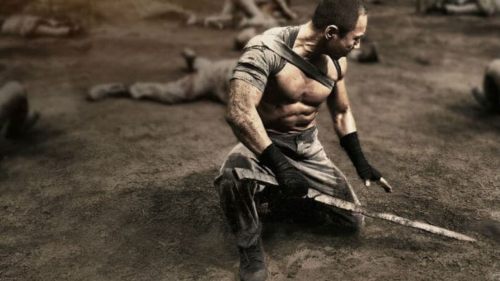ALTERED CARBON Review (Part I): The Politics Of Bodies
Hello! Jacob here! This review is Part One of our in-depth Altered Carbon coverage, as Andrew & I thought Netflix’s new show was far too dense for just one simple recap/rundown/review. So, with that in mind, think of this write up as encompassing the first five episodes of the cyberpunk thriller, while Andrew’s writing will take you down the home stretch. Enjoy!
Human bodies are usually a huge focus of most “cyberpunk” sci-fi cinema. Blade Runner (’82) zeroed in on the dreams of a disposable work force, wishing that they could extend their lifespans beyond the given number of years they were mass-produced with. Ghost In the Shell (’95) sees a cybernetically augmented human question the nature of her consciousness, as it thrives inside a mechanical structure. The Matrix (’99) finds all of humanity enslaved inside a virtual reality, as our species has been harvested by machines who’ve keep us comatose, but alive, for their own sustenance. These radical works are almost always the result of their authors attempting to reconcile spiritual anxieties with an innate fear of technological advancement. Can I still be me, if “me” is really manufactured to begin with?
Altered Carbon – Netflix’s lavish, huge-budgeted (at $100 million-plus) ten-episode adaptation of Richard Morgan’s eponymous novel – takes many elements from cyberpunk staples and remixes them into a gorgeously familiar mash-up, while still providing fresh interrogations for the characters stuck in its rainy, Dickian dystopia. Their environment is pulled straight from Ridley Scott’s playbook – all hazy neon urban mazes where the lower classes live, while the elite reside in high rise lofts well above the clouds. Our souls are now contained in “stacks”—glowing discs that exist in slots just beneath our brain stems – while our bodies are now simply referred to as “sleeves”: fleshy action figures that can be replaced upon destruction, should our stacks remain intact and you have the cash to buy yourself a new form. If you’re a janitor, chances are you’ll end up in a recycled ex-con, because that’s all you can afford. Should one belong to that Godlike literal upper echelon, you can buy the muscled figure of a fallen soldier (or simply have your body custom made, with duplicate clones that never expire).
Overly faithful to the 2002 novel by Morgan – and adapted by showrunner Laeta Kalogridis (Shutter Island) – it undeniably takes a second to get accustomed to the vocabulary of Altered Carbon’s universe. However, the basic plot is boilerplate cyberpunk. Deadly emissary Takeshi Kovacs (Will Yun Lee) is killed in the first scene during a hotel siege (with some rather alien-looking goose-steppers), only to awaken 250 years later in the unusually fit body of Elias Ryker (The Killing’s Joel Kinnaman), a former cop who once had a thing with another officer named Kristin Ortega (Martha Higareda). Ortega keeps tabs on Ryker/Kovacs – often against her boss’ wishes – and discovers her former flame (or, at least, her ex-lover’s body) is now under the employ of Laurens Bancroft (James Purefoy), a “Meth” (or Methuselah*), that can afford to keep his stack in circulation from now until the end of time. Kovacs’ job? To find out who killed off the body the rich man held so dear, as Bancroft couldn’t help but take this murder as a personal affront to his public status as the ultimate one-percenter.
As you can see, Altered Carbon’s set up is another film noir derived detective story the subgenre is so known for. However, the real fun to be had comes via the details that’re woven into the world building, particularly the hotel where Kovacs stays (and the AI sidekick that comes along with it). The Raven is named – you guessed it – for the famous poem by Edgar Allen Poe. Yet to simply have a Gothic inn become one of the series’ main settings would feel like cutesy cosplaying for the sake of it. One-upping this notion is the inclusion of Poe himself as a smart aleck character (played by Chris Allen). The groundskeeper can become your best friend or worst nightmare, depending on who’s paid him what, but cultivates a certain fondness for Takeshi and his plight. Together, the cop and reimagined writer become one of the more unexpectedly entertaining duos to grace the screen in some time, taking what could’ve been total theater kid wankery and making it clever and affecting. A genuine bond forms between the trapped investigator and this baroque computer simulation, adding another layer of cross-examination to the proceedings, as various forms of technological incarnations are inherently explored.
To be frank, the “mystery” element of Altered Carbon is (wisely) window dressing for the show’s greater concerns regarding identity and faith. The very concept that our main hero is an Asian man stuck in the body of a handsome white soldier is confronting instances of Hollywood whitewashing head on, as the Caucasian sleeve is disposable compared to the indomitable spirit of the PoC living in the disc at the base of his brain. Throughout the course of Altered Carbon’s narrative, we meet several other characters who were born one race, but then died and were forced to repopulate inside a sleeve whose skin pigment they don’t identify with (a running gag where a Spanish grandmother is stuck inside a burly white biker is absolutely hilarious). Yet this aesthetic dissonance forces the viewer to confront one of the story’s main themes: external ethnicity and sex do not define who we are as human beings. It’s our soul that guides us, and those who judge otherwise are fools.
Faith is also a major component of how Altered Carbon approaches its central conceit, as various religions have formed (or re-formed) during the near three hundred years since Takeshi was first killed. Nuevo Catholics – a study whose guidelines this writer would love to know more about – believe that we’re born with one body only, and that “re-sleeving” is a sin against the Creator. Others have rejected this conception, positing that belief structures should evolve with the technology that is advancing human existence. These are all heady, strange philosophical concepts, packaged inside this pulp construct. As the hours move along, it becomes clear that Kalogridis and her team of writers are just as interested in probing the deeper meaning of these future days as they are in ever solving the death of Laurens Bancroft’s precious body.
That said, there’s still a healthy amount of screen time devoted to the requisite sex and violence that dominates the cyberpunk subgenre. All of these characters are incredibly horny and/or furious, as daughters borrow the sleeves of their mothers to fuck foreign partners (just to see what mommy “feels like” inside), while zero-g arenas of combat are created by the upper classes, so that the gladiators can earn themselves a new form at the expense of onlookers and gamblers. Netflix has spared no expense bringing Morgan’s world to life, as the visual splendor and action set pieces are rather dazzling (not to mention coated in various human fluids). There’s even a whole episode devoted to virtual reality torture, as Kovacs is bound and dismembered in his own mind’s eye, repeatedly, as his white supremacist assailants strive to extract a secret from the deepest levels of his consciousness.
By the mid-point of Altered Carbon, it’s made clear that this world is incredibly multi-faceted; stretching the limits of its narrative building blocks and familiar subgenre elements. However, Netflix’s show deserves plenty of credit for not overexplaining the rules that govern its universe, and just charging straight ahead on the assumption that viewers will keep up. If you’re willing to engage with the hyper-nerdiness of it all and allow your brain to be immersed in the show’s velvety anti-reality, Altered Carbon should prove to be a perverted, hyper-violent delight; just aware enough to draw you in, but totally unique in its constant digressions and trippy milieu of unending human lives, courtesy of science fiction.
*Named for an ancestor of Noah believed to have lived 969 years.



